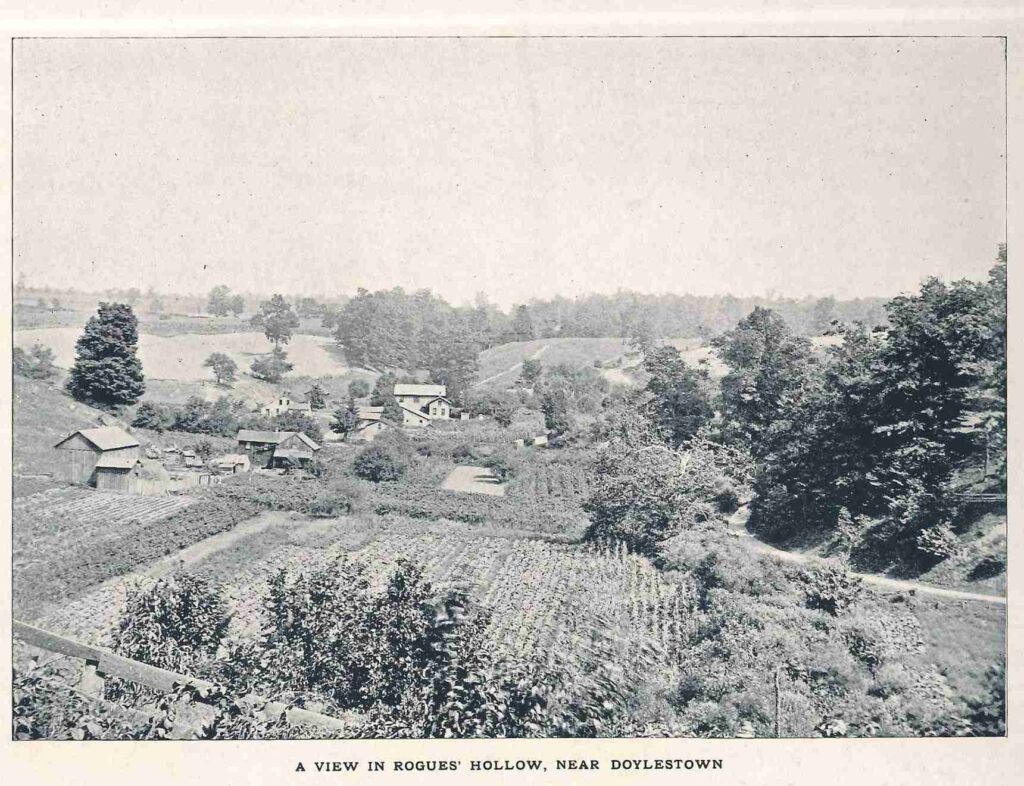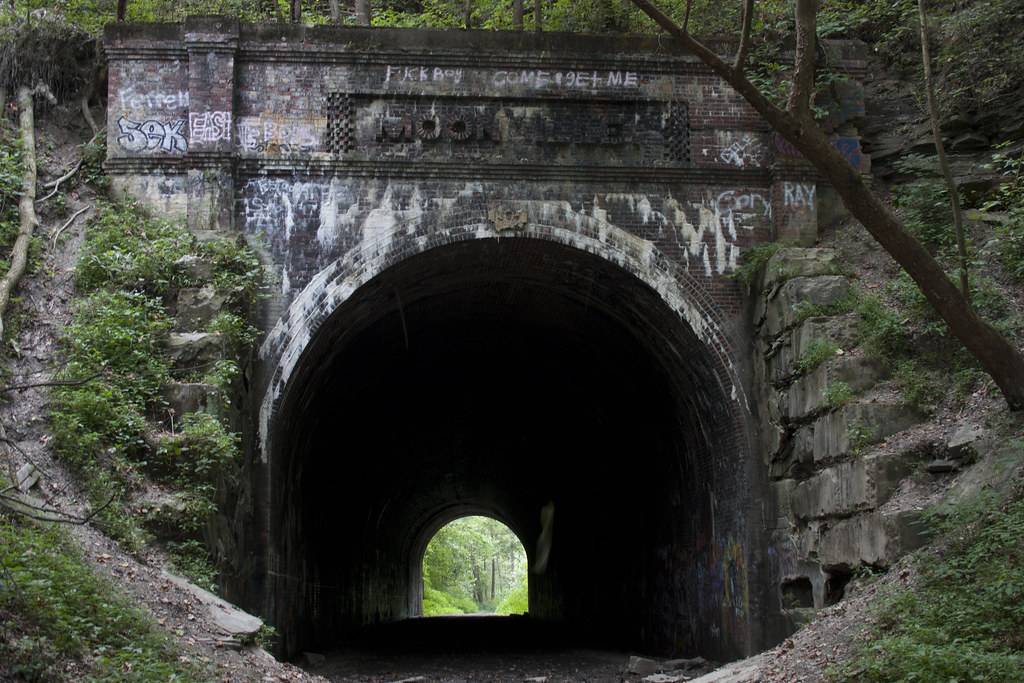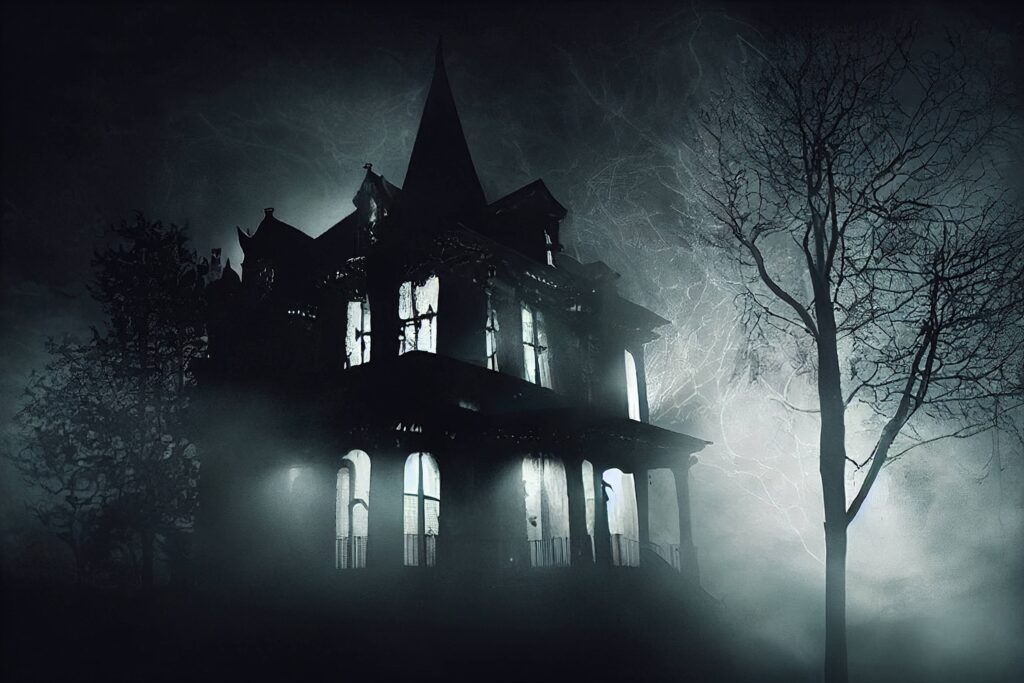Rogue’s Hollow is, depending upon who you ask, one of the more haunted places in the state. There is no shortage of tales that include words like “murder” or “ghost” or “curse” or “moonshine” or, I kid you not, “headless horse” (not headless horseman, sorry Ichabod Crane fans). Even though the town no longer exists beyond its Ghost Town status, the stories and legends about the place continue to be told to this day.
The History of Rogue’s Hollow
The history of Rogue’s Hollow began, we think, in the early 1800s. In 1811, a man named Thomas Frederick moved to the area from Pennsylvania and built himself a homestead. Over the next several years, a few others entered the region, but it wasn’t until 1927 when William Doyle moved in, purchased fifty acres of land and decided to survey the land so a town could be built which would ultimately be named after him, Doylestown.
By the 1840s, Doylestown had grown a bit, mostly owing to Coal Mining and the industrial boom that was going on at the time.
About a mile south of town, a mill was constructed and with it a few homes as well, and the locals started calling it (unofficially) Peacock Valley, perhaps because the area was as beautiful as a peacock. But, don’t worry – that name won’t stick around for long.
Not everyone who moved into the valley was exactly a law abiding citizen and soon the area became known as a place where outlaws would hang out and hide. It quickly gained quite a violent and “wild” reputation. Soon, the locals in and around Doylestown started referring to it as Rogue’s Hollow.
While there is something between little to nothing left of the town left on earth, records and historical documents still exist. And, some of the stories they tell make it pretty clear how the area got its wild reputation.
Stories From Rogue’s Hollow
One of the earliest accounts I’ve discovered comes from a report from the Akron City Guard, Camp Wykoff Detachment. While the troupe was marching through Rogue’s Hollow, they witnessed one of the Mount Vernon Guards striking a resident with his fist, then throwing a tumbler at his head. They also noticed that the rest of the Mt. Vernon guards looked disheveled, bruised and bloody. (I was not able to discover what Mt. Vernon guards were doing so far away from home.) The Akron men declined to intervene, not wanting to interfere in such kinds of warfare.
In 1881, a man who lived in Rogue’s Hollow was upset with his neighbor, Mrs. Ellis, over a recent dog fight. When he went to confront her, the two got into such a brawl that the following day, the man went before the judge in Doylestown covered in scrapes and bruises and sought her arrest. The following day, she appeared in court, but the man did not so all charges were dropped.
Two months later, a man named Jim Miller got drunk one evening and spent some time chasing his wife around town with a gun and threatening to shoot her. After an hour or so, several of the men in town came to her aid and managed to wrestle the man to the ground and forced him to Doylestown to appear before the judge, where he was bound over for trial.
The following year, Peter Anfang was beaten to death by George Dieble after Anfang accused Dieble’s brother of seducing his sister.
In 1885, Irish pub owner Michael Welsh beat his wife to a painful death with a beer mug. He was arrested and taken to Doylestown where he was still too drunk to stand trial, so he was bound over for a day or two to stand trial.
As most (if not nearly all) residents in the Rogue’s Hollow area were connected to the mining industry, which was in its infancy at the time. Due to the lack of regulations, safety considerations were nonexistent, and being such a relatively new field, there was so much about mining that had yet to be learned. Also, the commercial nature of industry, the price for anything being pulled out of the ground fluctuated wildly, even over a short period of time. Prices could double one month, only to fall to a mere fraction a year later. This would lead to fights and disagreements between the miners themselves, as well as everyone else in the industry.
Life for miners in this period of time is also rough. Minors got paid by the product they produced, not by the time they spent at work, so most worked six, if not seven days a week (and they likely worked more than eight hours a day). The work was physically demanding, and with the high rate of accidents and deaths happening regularly, mentally things could be pretty awful, too. In small towns like this, the only source of entertainment, the only place to unwind after a long, grueling day at work, was the local saloon. And sometimes inebriated men can do the weirdest things.
The men of Rogue’s Hollow would also fight each other for fun or sport. Several of the local salons kept leaderboards, listing the champion fighters in various weight classes. There are also reports where groups of visitors came to town, got drunk, and ultimately started to fight while being cheered on or taunted by the locals.
Many of the unusual stories that have been recorded give us an interesting view of what life was like at the time in Rogue’s Hollow. Personally, my favorite story so far … well, I’ll let you read it for yourself.
John Gillespie, of Rogue’s Hollow, brother of the woman who got drunk and was overturned on North Broadway, a few nights ago, went to sleep on the sidewalk on Mill street Monday night and says he was robbed of $50, for which he intends to sue the city.
(I have so many questions. She was “overturned”? He wants to sue the city because he says someone robbed him when he slept on the sidewalk? Did he, and did he win? Let’s start there.)
Legends From Rogue’s Hollow
There’s a crybaby bridge in Rogue’s Hollow. They say, at night, if you drive onto the bridge and turn your car off and just sit for a spell, you’ll start to hear a baby crying. According to legend, a long time ago a carriage driven by a mother with her infant son fell off the bridge. The mother was killed instantly, but the child survived for some time, crying out for attention, before ultimately expiring herself in the cold water. That is why you can still, sometimes, hear her ethereal cries.
Near what is now Route 65 once rested an old (or… large) oak tree. One winter evening, a runaway horse was galloping as fast as it could down a path that took it under the limbs of the tree. However, because the branches of the tree was weighted down with snow and ice, it caught the horse at the neck, decapitating the animal, but not necessarily sending it to the afterlife. Ever since, people have spotted a “Headless Horse” running around at dusk, perhaps reliving its final moments on earth.
Some people say that on certain nights, if you stand near the railroad tracks, you can hear a phantom train off in the distance. They say it gets louder as it approaches. Some even claim to have seen phantom lights, too, following the train tracks. However, as soon as the train almost gets to you – the sound stops and the lights disappear.
There are those, too, who have said they saw a pale lady, dressed in some sort of gray, frontier days style of dress. She will stand by the tracks, as if she is waiting for someone. Should you try to approach her, she’ll just disappear. But, she’s just one of many ghosts that people say they see here.
Frankly, there are so many myths and legends around Rogue’s Hollow that I would say someone should write a book if it wasn’t for the couple of people who already have.
This raises the question … Why is it that such a small geographic area is filled with this many ghosts and legends? As far as ghost towns go, this one ranks among the smallest, with a population of just over two hundred, as best we can tell. Did something major go on here?
Maybe, as others have claimed, the clue is in the name. Rogue’s Hollow.
We know from public records that more than a handful of outlaws (otherwise known as wanted criminals) came to live in Rogue’s Hollow. We know that illegal moonshine (especially during Prohibition) was easier to get there than water. We also know there was an overly macho culture, full of men fighting for the fun of it, or to settle conflicts, and many of the town ladies had no problem keeping up. We can see that “outsiders” weren’t exactly welcomed, except perhaps for an evening’s entertainment.
So, maybe all these stories were embellished a bit, if not completely made up in an effort to keep people away. The town seemed fine taking care of itself, and the last thing they likely wanted was for someone to report to law enforcement that Outlaw Pete was residing in the basement of the sawmill or that bank robber Steve “worked” in that barn over there. Therefore, if they made the place sound as scary as possible, June and Ward Cleaver would take Wally and The Beaver elsewhere for an afternoon of whatever.
Rogue’s Hollow Today
Today, Rogue’s Hollow is nothing like the nineteenth century version of itself. Even though I have never been, it sounds like the people there today are actually kind of friendly, although the bar had been set so low anything might seem like an improvement. Every so often, someone raises the idea of changing the name of anything that still has the old name (Rogue’s Hollow Road, for example) but the citizens don’t seem to mind it. Actually, you can almost think they want to keep it because it sounds kind of badass.
There is, however, one place that’s worth checking out – the Chippewa-Rogues Hollow Historical Society which people still say they’re the go-to place for correct historical information, so maybe they’d still be worth checking out.



